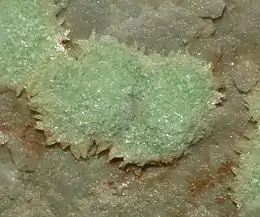| Heinrichite | |
|---|---|
 Green Heinrichite crystals and pale yellow Abernathyite crystals | |
| General | |
| Category | Phosphate mineral |
| Formula (repeating unit) | Ba(UO2)2(AsO4)2·10H20 |
| IMA symbol | Hrc[1] |
| Strunz classification | 8.EB.05 |
| Dana classification | 40.2a.9.1 |
| Crystal system | Monoclinic |
| Crystal class | Strunz |
| Unit cell | a = 7.155 Å, b = 7.134 Å, c = 21.29 Å β = 104.171 |
| Identification | |
| Color | Pale yellow, pale green |
| Streak | Pale yellow |
| Optical properties | uniaxial (−) |
| Refractive index | nω = 1.605 nε = 1.573 |
| Birefringence | 0.032 |
| Ultraviolet fluorescence | Yellow-green in longwave and shortwave UV[2] |
| Other characteristics | |
| References | [2] |
Heinrichite is a monoclinic-prismatic containing arsenic, barium, hydrogen, oxygen, and uranium. The mineral is named after Eberhardt William Heinrich (1918–1991) who first noted it in 1958 in the U.S. State of Oregon.
Description
Heinrichite is radioactive pale green, pale yellow mineral. Heinrichite fluoresces light-green in longwave and shortwave ultraviolet.[3] Because of its uranium content, the mineral is radioactive.[3]
References
- ↑ Warr, L.N. (2021). "IMA–CNMNC approved mineral symbols". Mineralogical Magazine. 85 (3): 291–320. Bibcode:2021MinM...85..291W. doi:10.1180/mgm.2021.43. S2CID 235729616.
- 1 2 "Heinrichite". Mindat. Retrieved November 20, 2020.
- 1 2 "Heinrichite". Mindat. Retrieved November 20, 2020.
This article is issued from Wikipedia. The text is licensed under Creative Commons - Attribution - Sharealike. Additional terms may apply for the media files.